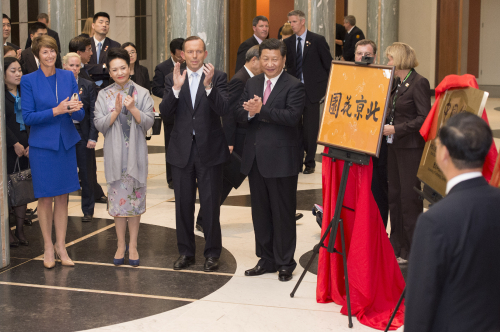|
 |
|
ENHANCING MUTUAL UNDERSTANDING: Visiting Chinese President Xi Jinping (right) and Australian Prime Minister Tony Abbott attend the unveiling ceremony for the Beijing Garden in Canberra, the Chinese culture center in Sydney and the Chinese library of the library of Sydney's University of Technology, in Canberra, on November 17 (MA ZHANCHENG) |

Chinese President Xi Jinping made his visit to Australia as China's top leader in November, although he had already visited the country four times before. It happened at a time when Australia was hosting a major conference that was attended by many of the world's leaders. The G20 summit in Brisbane presented an opportunity for the first ever visit to Australia by a sitting French president and an Indian prime minister. It also brought together figures like President Barack Obama of the United States, Chancellor Angela Merkel of Germany and President Vladimir Putin of Russia. Despite this intense activity, the Chinese president's visit attracted the most commentary within Australia. Xi's side trips on a state visit to Canberra, Sydney and then Tasmania before going to New Zealand and Fiji offered the first chance for Australians to hear first-hand what he thought about their country.
It is clear that Xi carries fond memories of his previous visits to Australia, and this comes across in the way he spoke. In parliament in Canberra he noted that the two countries were now major trading partners, which formed the core of their relationship. Over 50 percent of Australian iron ore now goes north to China, and a third of its exports are accounted for by the People's Republic. All of this has happened in a relatively short span of time. Until as recently as 2009, Japan was the main trading partner of Australia before China overtook it. Xi also made note of the 200,000 Chinese students now in Australian schools and universities. This too was almost non-existent over a decade ago.
Despite all of these tangible links, the Chinese leader expressed some frustration over how Australia views its relationship with China. He asked for a greater and more complex vision, perhaps referring to the way that Australian leaders are almost always framing the relationship in terms of economic benefits and not looking deeper into issues like security and regional governance. It was also a polite criticism of Australia's diplomatic closeness to the United States, to the point that even decisions about joining the infrastructure bank established in China in September were stopped at the last minute in Canberra reportedly because of pressure from Washington.
The final announcement of the free trade agreement (FTA) between Australia and China after almost a decade of discussion was the biggest headline of the day on which Xi spoke in Canberra. The Australian press described the FTA in terms of Australian agriculture being the winners, gaining access to the Chinese market with most import tariffs either being reduced or phased out over the next four to five years. Agriculture is symbolically important in Australia, and receives much political attention. Even so, the service sector makes up 80 percent of the economy. The provisions in the FTA here, if fully and successfully implemented, are of more long-term significance.
This was probably the most important aspect of Xi's visit, and shows that the FTA has to be viewed in a more sophisticated way than simply seeing it through the frame of winners and losers. It is important to recast Australia in Chinese eyes as more than just a tourist destination or somewhere for Chinese students to attend university. It is now more crucial than ever to present Australia as a place where the trade relationship is based on more than just iron ore or coal, but on a flow of ideas, a sense of shared destiny for the region, and some notion of common strategic outcomes.
Australia is not a manufacturing center, and its cars and other consumer goods are mostly imported. But it is a very diverse, highly educated population, where the vast majority of the jobs are in finance or services. These are the main growth areas of the economy now, and finding a way in which the country can get better access to its main trading partner is important. Part of that battle is to present Australia as a place where finance and services are undertaken at a high level and where a services partnership is a concept both sides buy into and gain from. This is an issue therefore not of winners and losers but winners and winners.
The FTA, like any similar agreement, presents a framework for rules-based engagement. But it should never be seen as a cast iron deal whereby companies are almost guaranteed a slice of a foreign market. In that sense, the FTA is better viewed as the start of a game after the rules have been agreed upon by both sides. On the whole, too few Australian companies look at China as a market they can work in. Banks like Australia and New Zealand Banking Group have been very active, with a branch in the Shanghai Free Trade Zone undertaking renminbi business, and Westpac has started to be more active there. But as a report issued by the University of Sydney and the Financial Services Institute of Australasia on November 17 on financial services between the two countries showed, in 2013 the flow of goods and services from Australia into China was less than 6 percent of the overall figure of exports. As Chinese demand for commodities slowly drops, this services component becomes increasingly important. But the various banks, insurance companies, fund managers and service providers across Australia must now consider seriously whether or not to engage with China, and if so how. The existence of the FTA at least poses these tough questions, even if it doesn't offer easy answers.
With New Zealand, things are more straightforward. New Zealand signed one of the earliest FTAs with China over six years ago, and on the whole is seen as a predominantly agricultural supplier. One of the issues that New Zealand shares with Australia is whether China will be allowed easier investment access. In the past, Chinese attempts to purchase agricultural land or companies in both places has proved challenging, with public perceptions often negative. Australia has agreed in principle to raise the ceiling for Chinese direct investment to AU$1 billion (about $0.9 billion) before it gets referred to the scrutiny board. New Zealand is also looking for more diverse investment from China, and a more complex relationship.
Xi's final leg of his journey to Fiji only illustrates just how diverse diplomacy is becoming. This was the second time he has visited the island, the first being when he was vice president in 2009. To receive so much high-level attention from the world's second largest economy is impressive, but it also indicates just how China now sees its regional role, with links extending out far beyond its traditional areas of strategic concern. Once more, deepening economic links was the top priority.
Following this visit, people in the region have a much clearer idea of how the Chinese leadership views them. Xi was able to present a new face of Chinese modern diplomacy to the Australian people, and those that heard him speak while he was in the region, either in person or on television, were impressed by his informality and his ability to engage with them in a relaxed and natural way. Whether Australians, New Zealanders or Fijians think more strategically about their relationship with China is impossible to answer at the moment, however. We will know in the next year or so whether they have taken up the challenge. But the infrastructure is now in place, and the diplomatic atmosphere is suitable for significant advancement. Now it is simply a case of showing the willingness to take action.
The author is an op-ed contributor to Beijing Review and executive director of the China Studies Center at the University of Sydney
Email us at: yanwei@bjreview.com |
